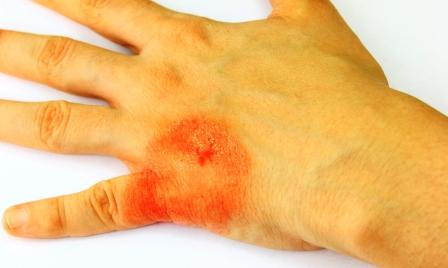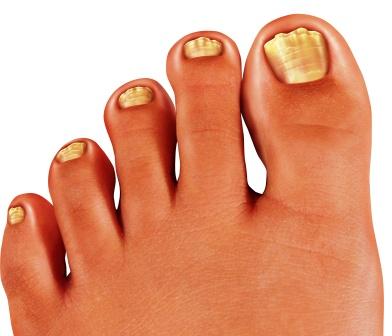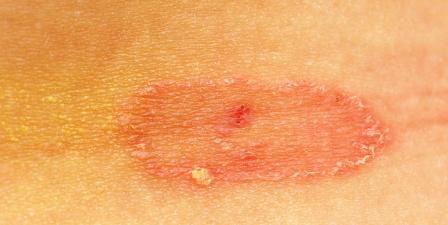Ayurvedic Treatment For Ringworm, Dermatophytosis, Tinea
Dadru – ringworm, dermatophytosis or tinea infection is a burst out condition of the skin. Due to bursting of exterior through the skin leads to circular or different shaped skin patches with itching. It is also commonly explained as fungal skin infection. This skin disease is explained in the Ayurvedic textbooks as old as Charaka and Sushruta Samhita.
Table of Contents
Clinical features
| Clinical features | Charaka | Sushruta | Vagbhata |
| Color | Red | Dark brown | Wide spread |
| Itching | Present | Present | Present |
| Patches/lesions | Present | Not specific | Present |
| Blisters | Present | Present | Present |
| Spreading nature | Not specific | Wide spread | Constantly spreading |
| Association of other diseases | Not specific | Not specific | Associated |
| Doshic dominance | Kapha Pitta dosha | Kapha dosha | Kapha pitta dosha |
| Classification | Kshudra Kushta – Minor skin disease | Major skin disease | Major skin disease |
As per modern science the fungal infection which is caused by dermatophytes is called dermatophytosis, Tinea or ring worm. The term Tinea refers to worm in Latin. Ringworm is suggestive of the circular skin lesions with elevated edges.
Tinea infections are characterized by circular lesions which usually have margins with raised edges and single lesions. It may also lead to plaque.
Symptoms Include itchy ring like scaly patches which later forms pus filled blisters on skin. If it occurs in nail then the nails get crumpled, discolored and thick and if in scalp one can loose scalp hair and get bald patches.

Name according to site of lesion
Depending upon the site of affliction the lesions are named as below-
Scalp -Tinea capitis – also known as scalp ringworm
Body -Tinea corporis
Whole body surface -Tinea universalis
Neck -Tinea versicolor
Face -Tinea faciei
Beard -Tinea barbae
Groin and buttock -Tinea cruris – also known as jock itch
Hand -Tinea manuum
Feet-Tinea pedis – athlete’s toes, athlete’s feet
Nails-Tinea unguium

Predisposing factors
Predisposing / promoting factors for fungal skin infection:
Poor nutrition – leading to less immunity, more proneness to infection
Excessive sweating Hot and humid climate – excessive sweating, leading to moist skin
Debilitating/ chronic diseases – compromised immunity
Poor hygiene, poor living conditions,
Diabetes – diabetic patients are usually more prone to skin diseases
Administration of cortico- steroids and immune suppressing agents, leading to compromised immunity. More chance for the fungus to invade.

Causative factors
Causative factors for Dadru (Tinea infection) according to Ayurveda:
Food and habits increasing Kapha and Pitta – itching and burning sensations are the pridominant symptoms, contributed by Kapha and Pitta respectively.
Incompatible food – wrong food combinations
Excess intake of sea food
Heavy food intake
Intake of sour curd and milk, together, in excess for long period of time
Excess intake of black gram.
Candidiasis or Yeast Infection
caused by yeast (a type of fungus) infecting the skin or attacks the mucous membrane. Often dark, warm and moisture are driving forces for this fungal infection. They live in the body but are not active or dominant. It is only when they get the optimum conditions, do they multiply and get converted into Candidiasis.
Symptoms: Include rashes, pus filled patches, pimples and extensive itch on the infected area
Subcategories of Ringworm Fungal Infection
a) Athlete’s foot (Tinea Pedis or Foot Ringworm) – it is a fungal infection which affects the feet. Athlete’s foot causes the skin to get whitened between the toe with itch and rashes. Mostly seen to occur in Athletes and adults male due to moisture, sweat and unhygienic conditions in socks and shoes.
(Tinea Pedis or Foot Ringworm) – it is a fungal infection which affects the feet. Athlete’s foot causes the skin to get whitened between the toe with itch and rashes. Mostly seen to occur in Athletes and adults male due to moisture, sweat and unhygienic conditions in socks and shoes.
b) Scalp ringworm (Tinea Capitis) – very contagious fungal infection which affects children in age group from 2 -10. This infection occurs in head and scalp region.
c) Nail ringworm (Tinea Unguium) – occurs in the nails and finger due the conducive conditions found there. It is again a very itchy fungal infection.
d) Body ringworm (Tinea Corporis) – Can occur anywhere on skin which is accompanied with ring like formation.
Line of treatment
Line of treatment of fungal skin infection – Dadru Chikitsa:
As the disease is due to predominant vitiation of kapha and Pitta, measures are taken so as to pacify these two doshas first.
If the condition is severe and disease is chronic in nature,
Vamana Panchakarma (Classical emesis) is to be carried.
External medications are carried like washing, cleansing etc to prevent super infections.
Herbs used
Herbs and substances useful in Dadru kushta (Tinea infections):
Bakuchi-Psoralea corylifolia – used in wide range of skin diseases including leucoderma.
Tuvaraka-Hydnocarpus laurifolia – also useful in fever, diabetes, hemorrhoids etc. Its oil Tuvaraka taila is used for external application.
Jati-Jasminum officinarum – main ingredient of many skin medicines like Jatyadi oil.
Nimba-Azadirachta indica
Patola- pointed gourd – Cucumerina dioica
Dhattura-Belladonna-Dhatura metel
Karaveera-Nerium indicum
Daruharidra-Berberis aristata
Haridra-Turmeric-Curcuma longa
Karanja-Pongamia pinnata
Aragwadha-Cassia fustula
Mriddarashringa-Litharge
Gandhaka – Sulphur
Haratala -Purified Yellow arsenic (to be used under medical supervision)
Tuttha – Copper sulphate solution is used externally in skin disorders (to be used under medical supervision)
Ayurvedic medicines
Ayurvedic medicines for Dermatophytosis:
Gandhaka rasayana – used in the treatment of skin diseases, itching, chronic fever, urinary tract disorders etc. Available in tablet and powder form.
Arogyavardhini vati – used in the treatment of liver diseases, fever, skin diseases, etc
Aragwadhadi kashaya – used in the Ayurvedic treatment of vomiting, diabetes, skin diseases with itching and non healing wounds.
Haridra Khand – used widely in the treatment of allergic skin diseases, itching skin diseases. It improves skin quality and complexion.
Rasamanikya – in tablet or powder form. It is used in the treatment of fever, bronchitis, Asthma etc.
Mahatiktaka kashaya – used to treat wide range of skin diseases, abscess, non healing wounds and sinuses.
Panchatiktaka guggulu – used in skin diseases and fever.
Guggulu tiktaka kashaya – used in treating inflammatory conditions of skin, joints and bones.
Hajrul Yahood Bhasma – mainly used in urinary calculi, used for external application for skin disorders in children.
Patoladi Kashayam
Nimbamritadi kashayam
Nimbadi kashayam Tablet / Nimbadi Kwatham tablet
Nisha Haridradi Churna
External application
Medicines for external application for tinea infection:
Jatyadi oil – used for quick wound healing in blisters, sinuses, non healing wounds etc. it is used for external application.
Dhurdhurapatradi Thailam – especially useful in tinea capitis (scalp fungal infection)
Nalpamaradi taila – especially useful for massage of whole body infection – Tinea corporisGandhakadya malahara – used to treat skin diseases such as dermatitis, fungal infection etc.
Rasottamadi lepa – Mahamanjishthadi taila
Jasadamrita malahara – Made out of zinc oxide
Sindooradi malahara
Ayurvedic home remedies, tips
Tips and home remedies for fungus infection:
For any type of skin disorders due to infection – mix 10 grams of turmeric powder in 100 ml of neem oil. Apply it over the skin lesions, 30 minutes before bath, everyday. Believe it or not, a perianal abscess was cured with this simple remedy. (You can see a testimonial about it here)
For all skin disorders, mix a tablespoon of Khadira (Acacia catechu powder) in a tub of hot water and use it for bathing. Read more about this home remedy
In case of Jock itch (affecting groins), wear loose-fitting under garments. Apply cosmetic powder to keep the skin dry.
To prevent scalp fungal infection, do not use very old and infested combs, brushes and such other hair care products.
If you have groin fungal infection (Jock itch) and athlete’s foot together, then treating groin infection alone will not be sufficient. the foot infection can spread to groin and jock itch may recur.
Do not share cloth, sports instruments, towels with others
Wash thoroughly after suspected skin contact
Avoid tight-fitting cloths. Change your socks and underwear repeatedly, if needed.
After bath, make sure to dry the skin completely.
If you have athlete’s foot, put your socks on before your underwear so that the infection does not spread.
Avoid using oily skin products.
Reduce your exposure to the afternoon sun. Increased sweating causes worsening of infection.
Wear cotton cloth, which absorbs the sweat and moisture completely.
Avoid walking bare foot on beaches, locker rooms and swimming pool.
After a shower, completely dry all body parts to avoid moisture which could lead to fungal infection.
As a rule for preventing fungal infection never ever share personal products and items with anyone.
Wash your hands with a good antifungal soap regularly before meals and after touching contaminated places and articles.
Eat a healthy and wholesome diet.
Drink plenty of water to detoxify your body – approximately 8 -10 glasses is a must.
Tulsi for tinea cruris and ring worm infection:
Tulsi has anti fungal properties. Take 10 fresh leaves of holy basil and crush to extract juice. Mix a pinch of neem powder or turmeric powder to this and apply over the affected skin area. Do this for 10 days time.
Wholesome diet and habits
Wholesome diet and habits for tinea infection:
Warm water
Astringent-bitter and light food
Regular washing and bathing
Proper exercise – to improve body strength and immunity
Buttermilk
Light and easily digestible food
Turmeric, curry leaves, cinnamon, cardamom
Unwholesome diet and habits
Oily food, junk foods, sodas – upsets stomach and intestines, worsens immunity strength
Cold water
Dust and contaminants
Heavy and excessive food
Slimy and spicy food
Night awakening
Improper bowel habit etc
Last drop
Tinea infections are very common and it may affectany age group. Proper hygiene, regular health care, avoidance of the allergic chemicals are the easy ways to preven the possibility of this illness.
Article by Dr MS Krishnamurthy and Dr Hebbar










26 comments
dr.vinod sharma.
A good account of Tinea Infection.Thanx Dr.Hebbar .!
Dr J V Hebbar MD(Ayu)Author
Welcome sir 🙂
Praveen A V
Excellent article. Thank you Dr.
I have a question: If have couple of tiny infections of tinea versicolor on Cheeks(affecting facial hair growth 🙁 ), Chest, Hands.
I can apply turmeric + neem oil.
Won’t turmeric further affect facial hair adversly?
Dr J V Hebbar MD(Ayu)Author
In your case, turmeric would heal the tinea. Soon after the infection is relieved, you can stop applying turmeric + neem oil.
chandranshu thaker
I am teenager sir iam affected by internal ring warm can you suggest any ayurvedik home treatment? I hope you will do the needful as soon as possible
Regards
Harjeet Singh
Hiii plss tell me the treatment for ringworm I’ve ringworm on my body.. I’ve tried so many medicine and also ayurveda medicine but ringworm are not treated… Tell me any other options to cure this
Dr Malini Bhat
Hello sir, Here are some home remedies:
1. Take 1 tsp of crushed mustard seeds.Add little water to make a paste.Apply on affected area.Wash after 60 min with lukewarm water
2. Crush some tulsi leaves.Press the paste on a sieve and extract its juice.Take 2 tsp of this juice.Apply on the infected area using cotton.
You can undergo Vamana Panchakarma procedure for the same. Do consult a Ayurvedic Physician for the treatment procedure.
Mohan
Sir ringworm infections can be cured permanently in ayurveda as as I m getting reccurent infections inspire of all treatment.
nargis
sir is rinworm infection curable and which medicine i have to take
Dr J V Hebbar MD(Ayu)Author
It is curable. Please consult an Ayurveda doctor directly.
suman kukreja
Can ayurved cure recurrent ringworm completly
Permenently how much time treatment take?
treatment for ring worm
The article you posted in this blog is very clear. And I really impressed about your article. Thank you for sharing your great ideas with us.
Pandu Ranga Reddy Kallem
What is the common (combined) treatment for Tinea unguium, Tinea cruris and Tinea pedis.
Dr J V Hebbar MD(Ayu)Author
Requires doctor’s consultation.
Archana
Excellent post BT i have tinea corporis dey go as I apply been oil BT reappear at different spots again plz guide till how long do I have to keep on apply been oil as i clear 1 n after few days der is a new one. Plz help
sanus
can tulsi be used against jock itch?
Dr J V Hebbar MD(Ayu)Author
Nice to know. Thanks for sharing your valuable experience. 🙂
P
I having the fungus sice 8 month I have taken many medicine from yellopathy but it rid off but acure again n again finally i decided to take ayurvedic treatment. Now doctor has given me patolamoodi syrup, cutis cream, cutis poweder and cutika tablets for 7 days. After that i have to visit my doctor…. So how long I should take this course to fully get rid of fungus..?
Dr J V Hebbar MD(Ayu)Author
May be about 2 months time.
Dr J V Hebbar MD(Ayu)Author
About 6 weeks time.
srkret2015
Thanks for your post.
As per Siddha doctor instruction i tried cleaning groin area with Triphala churnam and applying cutis cream – derma care for 2-3 times daily.
Also I replaced inner-wear in a interval of 6 months to 1 year.
But it gives only temporary relief. Can you suggest better medicine or procedure for permanent cure.
I don’t have Diabetics.
Jaameen
Sir, I have ring worm proprob since 9 months, its
IncreasiIn daily, pleasepsuggestpmepsome aurvedic soap
Jaameen
Please suggest me some ayurvadic soap
Jinu
Hi sir,i have tinea infection for past 8 months i consulted doctor and took medicine and tablets but when I stopped it is increasing again.Now I’m planning to go for ayurvedic treatment..Is it good to change yo ayurvedic after the english medicine
Geetika
Thank you so much Sir!
It came out to be Contact Dermititis instead of Tinea.
What would you suggest for that? I applied Lacto Calamine and now since it has dried- I am applying pure coconut oil and turmeric.
What can be the reason for Dermatitis and how is that curable in Ayurveda? Is it that the blood is impure or due to dandruff or both?
Please help Sir ????????
Thank you so much
Prakruthi Sloka
Can we use haridra khand for brown patches all over the body… please suggest me